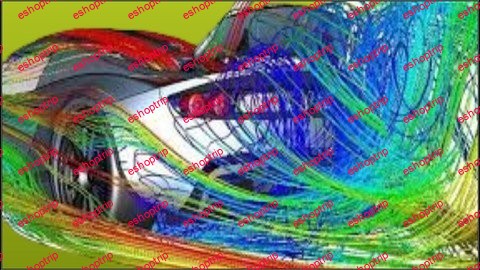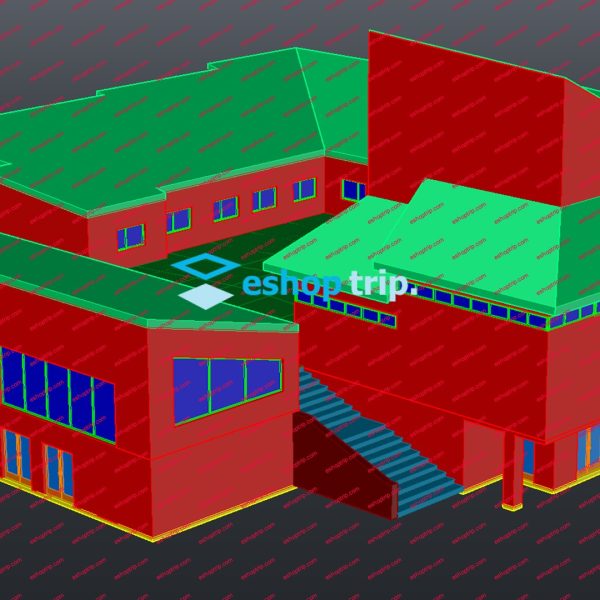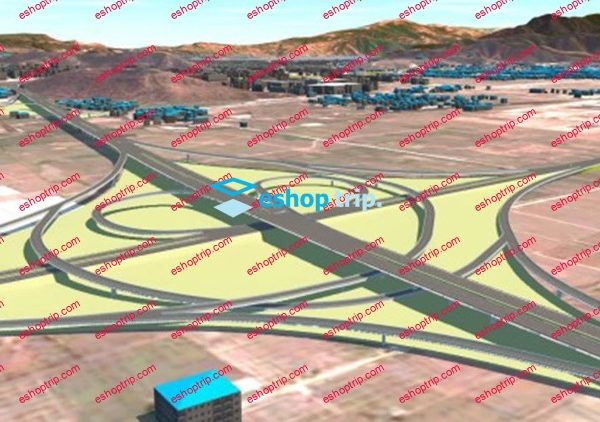Last updated 1/2022
MP4 | Video: h264, 1280×720 | Audio: AAC, 44.1 KHz
Language: English | Size: 5.96 GB | Duration: 9h 28m
CFD A Professional Approach to Solve Industrial Problems with ANSYS Fluent Fault Tolerant Meshing & Water Tight Geometry
What you’ll learn
Students will understand the detailed workflow in CFD Analysis with latest methodology adopted in ANSYS Fluent Fault Tolerant Meshing and Water Tight Geometry
Students will understand the latest Meshing Technique employed in ANSYS Fluent
Students will be able to rectify any geometry inaccuracy using repair tool using ANSYS Claim Repair Tool used in ANSYS Watertight Workflow
Students will be able to solve any industrial problem using ANSYS Fluent
Students will be able to analyze any CFD Problem using ANSYS Post Processing in a Simpler way
Students will be able to apply the detailed CFD Methodology to solve industrial problems perfectly
Requirements
Basics of Fluid Mechanics, Engineering Drawing, Any CAD Modeling Software
Description
In engineering analysis, CAD model plays an important role. It may have errors like merged faces, duplicate curves, extra edges, split edges, gaps or even interference errors. Therefore, we need to avoid dirty CAD Geometry and that to be repaired and converted to error free geometry. To avoid modelling errors, it is important to select correct and all the relevant physical models. The most important model for fluid dynamics is a set of partial differential equations called the Navier Stokes equations.After getting the error free correct geometry, we need to go for discretization or meshing. To have an accurate result we need to focus on better meshing quality because, better the mesh, better is the solution. To minimize the discretization error, we need to go on meshing and remeshing again and again till we reach the minimum error. When we get the exact solution then we say that convergence criteria achieved.From these theoretical understanding we can realize that in FEA or in CFD or in any kind of Engineering analysis meshing or discretization plays a very important role. Sometimes the geometry or the CAD model may be having some intersecting solids or surfaces. It may have errors like merged faces, duplicate curves, extra edges, split edges, gaps or even interference errors. In these cases, we cannot go for perfect meshing. Therefore, we need to rectify those errors using ANSYS space-claim repair tool and even we can share topology. So, if we require perfect meshing and after that if we want to go for different types of analysis like structural or CFD analysis, the we must say that ANSYS is best software. Here, to have a perfect meshing we can adopt different meshing methods like watertight geometry and fault tolerant meshing, which is new to ANSYS interface and it is been introduced in ANSYS 2021 version. Therefore, to be familiar with these new techniques we have developed this course considering different types of engineering applications with advanced techniques like watertight geometry, fault-tolerant meshing as well as with conventional approach.Accordingly, we have categorized this CFD course into three different units consisting of twenty videos relevant to industrial applications.The first unit comprise of ANSYS Fluent Fault tolerant meshing, consisting ten videos.The second unit comprise of ANSYS Fluent watertight geometry, consisting four videos and the third unit contains four videos with conventional approach of CFD Fluent flow analysis.Unit 1- CFD Flow Analysis with ANSYS Fluent Fault Tolerant Meshing:(i) Introduction to the Course(ii) CFD Heat Transfer Analysis through a Shell-Tube Heat Exchanger using ANSYS Fluent Fault Tolerant Meshing(iii) CFD Heat Transfer Analysis through a Counter-Flow Heat Exchanger using ANSYS Fluent Fault Tolerant Meshing(iv) CFD Heat Transfer Analysis through a Cross-Flow Heat Exchanger using ANSYS Fluent Fault Tolerant Meshing(v) CFD Heat Transfer Analysis through a Condenser Heat Exchanger using ANSYS Fluent Fault Tolerant Meshing(vi) CFD Heat Transfer Analysis through a Plate Heat Exchanger using ANSYS Fluent Fault Tolerant Meshing(vii) CFD Heat Transfer Analysis through a Surface Condenser using ANSYS Fluent Fault Tolerant Meshing(viii) CFD Fluid Mixing through a Special type Heat Exchanger using ANSYS Fluent Fault Tolerant Meshing(ix) CFD Heat Transfer Analysis through an Exhaust Manifold using ANSYS Fluent Fault Tolerant Meshing(x) CFD Heat Transfer Analysis through Catalytic Converter using ANSYS Fluent Fault Tolerant Meshing(xi) CFD Heat Transfer Analysis through a Wind Tunnel using ANSYS Fluent Fault Tolerant Meshing(xii) CFD Heat Transfer Analysis through a Venturi-meter using ANSYS Fluent Fault Tolerant Meshing(xiii) CFD Heat Transfer Analysis through an Expander using ANSYS Fluent Fault Tolerant Meshing(xiv) CFD Heat Transfer Analysis through Heat Pipe using ANSYS Fluent Fault Tolerant Meshing(xv) CFD Conjugate Heat Transfer Analysis using ANSYS Fluent Fault Tolerant MeshingUnit 2 – CFD Flow Analysis with ANSYS Fluent Watertight geometry:(i) CFD Watertight Geometry Workflow through a Wind Tunnel(ii) CFD Heterogeneous Fluid Mixing using ANSYS Fluent Watertight GeometryUnit 3 – CFD Flow Analysis with conventional ANSYS Fluent Flow(i) CFD Flow Analysis Ove a Cylinder Surface using ANSYS Fluent(ii) CFD Intermixing of Fluids in a Bent-Pipe using ANSYS Fluent(iii) CFD Flow through a Converging & Diverging Section (2D) using ANSY Fluent(iv) CFD Flow through a Venturi-meter using ANSYS Fluent
Overview
Section 1: CFD Flow Analysis with ANSYS Fluent Fault Tolerant Meshing
Lecture 1 Introduction
Lecture 2 CFD Analysis through a Shell-Tube Heat Exchanger using ANSYS Fluent
Lecture 3 CFD Heat transfer Analysis through a Counter-Flow Heat Exchanger
Lecture 4 CFD Analysis through a Cross-Flow Heat Exchanger ANSYS Fluent
Lecture 5 CFD Heat Transfer Analysis through a Condenser Heat Exchanger using ANSYS
Lecture 6 CFD Heat Transfer Analysis through a Plate Heat Exchanger
Lecture 7 CFD Heat Transfer Analysis through a Surface Condenser
Lecture 8 CFD Fluid Mixing through a Special type of Heat Exchanger
Lecture 9 CFD Heat Transfer Analysis through an Exhaust Manifold using ANSYS Fluent
Lecture 10 CFD Heat Transfer Analysis through a Catalytic Converter
Lecture 11 CFD Heat Transfer Analysis through a Wind Tunnel using ANSYS Fluent
Lecture 12 CFD Heat Transfer Analysis through a Venturimeter
Lecture 13 CFD Heat Transfer Analysis through an HVAC Expander using ANSYS Fluent
Lecture 14 CFD Heat Transfer Analysis through a Heat Pipe using ANSYS Fluent Fault Tolerant
Lecture 15 CFD Conjugate Heat Transfer Analysis using ANSYS Fluent Fault Tolerant Meshing
Section 2: CFD Flow Analysis with ANSYS Fluent Watertight geometry
Lecture 16 CFD Watertight Geometry Workflow through a Wind Tunnel
Lecture 17 CFD Heterogeneous Fluid Mixing
Lecture 18 CFD Heat Transfer through a Wind Tunnel with a Fan & Heat Sink
Section 3: CFD Flow Analysis with conventional ANSYS Fluent Flow
Lecture 19 Flow Over a Cylindrical Surface
Lecture 20 Intermixing of Fluids in a Bent-Pipe
Lecture 21 Flow through a Converging & Diverging (2D) Section
Lecture 22 Flow through a Venturimeter
Under Graduate, Post Graduate Engineering Students and any CFD Learner or Professionals working as an CFD Application Engineer
HOMEPAGE
https://anonymz.com/?https://www.udemy.com/course/cfd-a-pro-approach-to-solve-industrial-problems-with-ansys/











Reviews
There are no reviews yet.